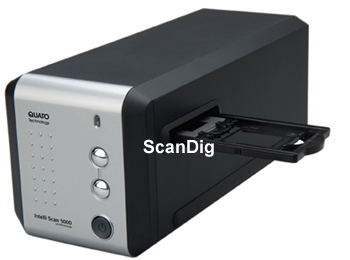Test report Quato film scanner IntelliScan 5000
At the beginning of the year 2006, just when Konica-Minolta, a well known manufacturer in the field of photography and scanners backed out of that segment, suddenly with the Quato company a new face on the film scanner market emerged.
The Quato Intelliscan 5000 is not available any more since the end of 2013. As a better alternative we recommend the Reflecta ProScan 10T. Back then many hadn't heard anything yet about the company Quato. Can a new company simply enter into an established market, where since many years established companies such as Nikon or Reflecta are on? Is it worth for a company to invest development work into a type of device, which will be useless one day anyway? Whoever takes the Quato IntelliScan 5000 into his hands or views a picture of the product in detail, will immediately notice that there's already such a device on the market and it's from the company Plustek.
A comparison between the Quato IntelliScan 5000 and the Plustek Optic Film 8200i shows quickly that the two devices are almost identically built, although their technical data is different. The housing dimensions, the shape, the control buttons and the film holders are nearly identical. Are we looking here at double series, like it is for example the case with the Reflecta DigitDia 5000 and the Braun Multimag SlideScan 4000b?

The Quato IntelliScan 5000 is a scanner, which raises curiosity, because the price is extremely moderate. With a resolution of 5000 dpi it seems to at least on the paper beat every presently available Nikon scanner; one can however foresee that the effective resolution will be clearly lower. Very nice is also the fact, that the SilverFast Studio version is included in the extremely low price.
But how good can a scanner be, which contains a professional software, which alone already costs half the price of the device? Is it an absolute bargain or is it cheap hardware being improved by adding known software? The technical data, the equipment and the software are much promising and the expectations are high.
We will nevertheless not provide a test report for the Quato IntelliScan 5000, since the device is indeed identically constructed like the Plustek. After further inquiry at the manufacturer Plustek, it turned out that Quato developed a driver for this device for Apple computers and sells the same device by their brand for PCs and Macs, while Plustek offers its device only for Windows PCs.
The film scanner Quato IntelliScan 5000 is identically constructed like the Plustek OpticFilm. Quato sells this device under license, but has however developed an Apple Mac driver in addition.
Compared to the Plustek film scanner OpticFilm 8200i, the Quato 5000 has a crucial advantage concerning the resolution: The Plustek OpticFilm 8200i has a nominal resolution of 7200 dpi, while the Quato IntelliScan 5000 only provides a nominal value of 5000 dpi. This sounds first as an advantage of the Plustek, but the actual resolution that one gets during the scanning is what is decisive. This is the same in case of both devices that is about 3300 dpi. In order to get actually a scan with 3300 dpi, one has to scan with the Plustek a slide or a negative with 7200 dpi, while in case of the Quato one only needs to scan with 5000 dpi.
A scan of a 35-mm film with 7200 dpi provides an image file of approximately 70 million pixels. To the contrary, a scan with 5000 dpi provides an image file with only 35 million pixels. But in both image files, there are only 15 million effective pixels, as both scanners only effectively scan with 3300 dpi. Thus, in case of one 7200 dpi scan with Plustek OpticFilm, one gets 55 million redundant pixels while with the Quato, one only gets 20 million redundant pixels. In both cases, the redundant pixels have to be reworked in the image processing program after the scanning, in which the image is reduced to a realistic size of approximately 15 megapixels. This process is very time consuming and requires a high computing power. The processing of an image of 70 megapixels that takes more than 200 megabytes, is considerably more laborious than the processing of an image of 35 megapixels that only needs a memory space of approximately 100 megabytes.
Buying a film scanner
Please, feel free to visit our online shop - it's the only shop on the Internet which is fully specialized on film scanners and accessories! We can provide you with any film scanner at an extremely attractive price and we also can supply you with accessories such as film holders or optional adapters.
Back to the film scanner tests index
|